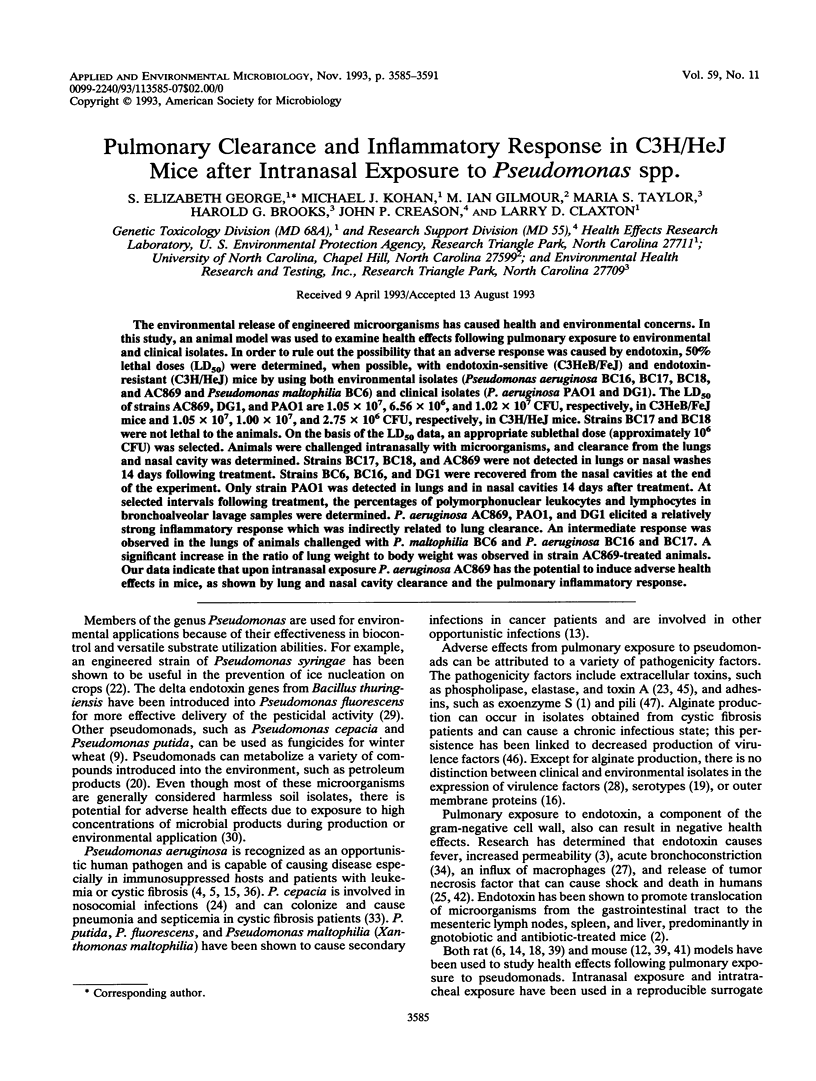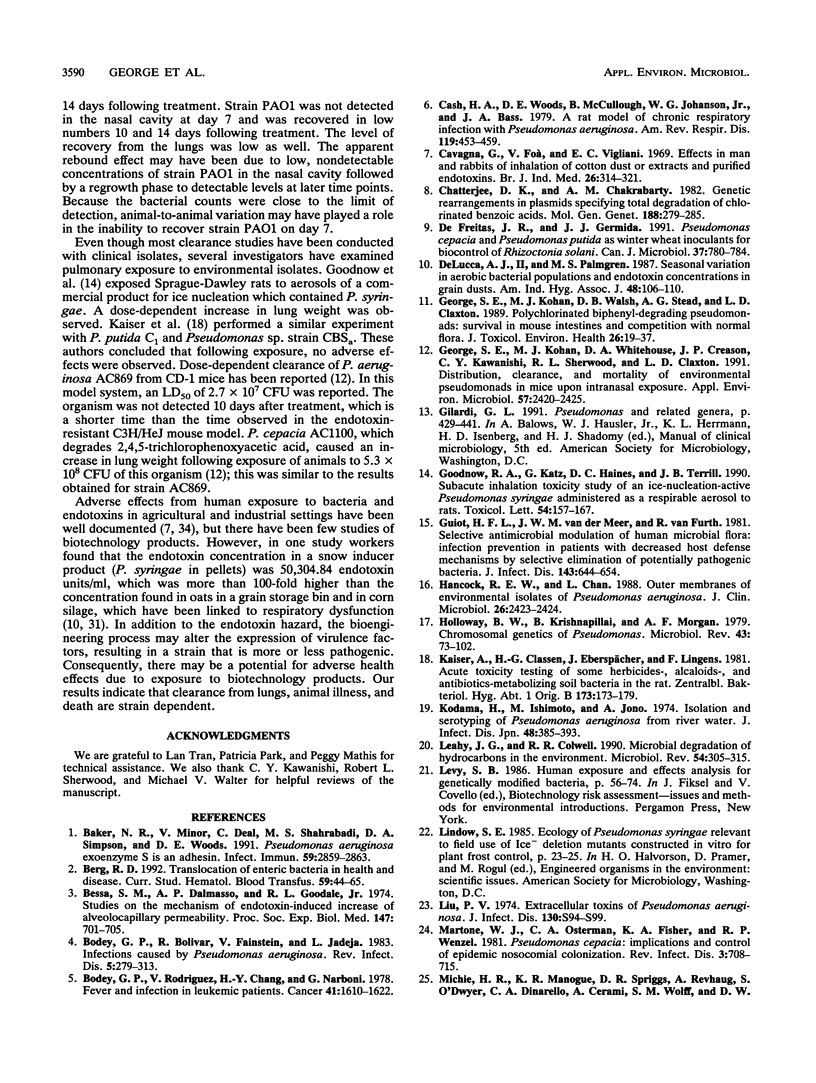Abstract
The environmental release of engineered microorganisms has caused health and environmental concerns. In this study, an animal model was used to examine health effects following pulmonary exposure to environmental and clinical isolates. In order to rule out the possibility that an adverse response was caused by endotoxin, 50% lethal doses (LD50) were determined, when possible, with endotoxin-sensitive (C3HeB/FeJ) and endotoxin-resistant (C3H/HeJ) mice by using both environmental isolates (Pseudomonas aeruginosa BC16, BC17, BC18, and AC869 and Pseudomonas maltophilia BC6) and clinical isolates (P. aeruginosa PAO1 and DG1). The LD50 of strains AC869, DG1, and PAO1 are 1.05 x 10(7), 6.56 x 10(6), and 1.02 x 10(7) CFU, respectively, in C3HeB/FeJ mice and 1.05 x 10(7), 1.00 x 10(7), and 2.75 x 10(6) CFU, respectively, in C3H/HeJ mice. Strains BC17 and BC18 were not lethal to the animals. On the basis of the LD50 data, an appropriate sublethal dose (approximately 10(6) CFU) was selected. Animals were challenged intranasally with microorganisms, and clearance from the lungs and nasal cavity was determined. Strains BC17, BC18, and AC869 were not detected in lungs or nasal washes 14 days following treatment. Strains BC6, BC16, and DG1 were recovered from the nasal cavities at the end of the experiment. Only strain PAO1 was detected in lungs and in nasal cavities 14 days after treatment. At selected intervals following treatment, the percentages of polymorphonuclear leukocytes and lymphocytes in bronchoalveolar lavage samples were determined. P. aeruginosa AC869, PAO1, and DG1 elicited a relatively strong inflammatory response which was indirectly related to lung clearance.(ABSTRACT TRUNCATED AT 250 WORDS)
Full text
PDF






Selected References
These references are in PubMed. This may not be the complete list of references from this article.
- Baker N. R., Minor V., Deal C., Shahrabadi M. S., Simpson D. A., Woods D. E. Pseudomonas aeruginosa exoenzyme S is an adhesion. Infect Immun. 1991 Sep;59(9):2859–2863. doi: 10.1128/iai.59.9.2859-2863.1991. [DOI] [PMC free article] [PubMed] [Google Scholar]
- Berg R. D. Translocation of enteric bacteria in health and disease. Curr Stud Hematol Blood Transfus. 1992;(59):44–65. doi: 10.1159/000429608. [DOI] [PubMed] [Google Scholar]
- Bessa S. M., Dalmasso A. P., Goodale R. L., Jr Studies on the mechanism of endotoxin-induced increase of alveolocapillary premeability. Proc Soc Exp Biol Med. 1974 Dec;147(3):701–705. doi: 10.3181/00379727-147-38421. [DOI] [PubMed] [Google Scholar]
- Bodey G. P., Bolivar R., Fainstein V., Jadeja L. Infections caused by Pseudomonas aeruginosa. Rev Infect Dis. 1983 Mar-Apr;5(2):279–313. doi: 10.1093/clinids/5.2.279. [DOI] [PubMed] [Google Scholar]
- Bodey G. P., Rodriguez V., Chang H. Y., Narboni Fever and infection in leukemic patients: a study of 494 consecutive patients. Cancer. 1978 Apr;41(4):1610–1622. doi: 10.1002/1097-0142(197804)41:4<1610::aid-cncr2820410452>3.0.co;2-b. [DOI] [PubMed] [Google Scholar]
- Cash H. A., Woods D. E., McCullough B., Johanson W. G., Jr, Bass J. A. A rat model of chronic respiratory infection with Pseudomonas aeruginosa. Am Rev Respir Dis. 1979 Mar;119(3):453–459. doi: 10.1164/arrd.1979.119.3.453. [DOI] [PubMed] [Google Scholar]
- Cavagna G., Foà V., Vigliani E. C. Effects in man and rabbits of inhalation of cotton dust or extracts and purified endotoxins. Br J Ind Med. 1969 Oct;26(4):314–321. doi: 10.1136/oem.26.4.314. [DOI] [PMC free article] [PubMed] [Google Scholar]
- Chatterjee D. K., Chakrabarty A. M. Genetic rearrangements in plasmids specifying total degradation of chlorinated benzoic acids. Mol Gen Genet. 1982;188(2):279–285. doi: 10.1007/BF00332688. [DOI] [PubMed] [Google Scholar]
- DeLucca A. J., 2nd, Palmgren M. S. Seasonal variation in aerobic bacterial populations and endotoxin concentrations in grain dusts. Am Ind Hyg Assoc J. 1987 Feb;48(2):106–110. doi: 10.1080/15298668791384472. [DOI] [PubMed] [Google Scholar]
- George S. E., Kohan M. J., Walsh D. B., Stead A. G., Claxton L. D. Polychlorinated biphenyl-degrading pseudomonads: survival in mouse intestines and competition with normal flora. J Toxicol Environ Health. 1989;26(1):19–37. doi: 10.1080/15287398909531231. [DOI] [PubMed] [Google Scholar]
- George S. E., Kohan M. J., Whitehouse D. A., Creason J. P., Kawanishi C. Y., Sherwood R. L., Claxton L. D. Distribution, clearance, and mortality of environmental pseudomonads in mice upon intranasal exposure. Appl Environ Microbiol. 1991 Aug;57(8):2420–2425. doi: 10.1128/aem.57.8.2420-2425.1991. [DOI] [PMC free article] [PubMed] [Google Scholar]
- Goodnow R. A., Katz G., Haines D. C., Terrill J. B. Subacute inhalation toxicity study of an ice-nucleation-active Pseudomonas syringae administered as a respirable aerosol to rats. Toxicol Lett. 1990 Dec;54(2-3):157–167. doi: 10.1016/0378-4274(90)90179-p. [DOI] [PubMed] [Google Scholar]
- Guiot H. F., van der Meer J. W., van Furth R. Selective antimicrobial modulation of human microbial flora: infection prevention in patients with decreased host defense mechanisms by selective elimination of potentially pathogenic bacteria. J Infect Dis. 1981 May;143(5):644–654. doi: 10.1093/infdis/143.5.644. [DOI] [PubMed] [Google Scholar]
- Hancock R. E., Chan L. Outer membranes of environmental isolates of Pseudomonas aeruginosa. J Clin Microbiol. 1988 Nov;26(11):2423–2424. doi: 10.1128/jcm.26.11.2423-2424.1988. [DOI] [PMC free article] [PubMed] [Google Scholar]
- Holloway B. W., Krishnapillai V., Morgan A. F. Chromosomal genetics of Pseudomonas. Microbiol Rev. 1979 Mar;43(1):73–102. doi: 10.1128/mr.43.1.73-102.1979. [DOI] [PMC free article] [PubMed] [Google Scholar]
- Kaiser A., Classen H. G., Eberspächer J., Lingens F. Acute toxicity testing of some herbicides-, alkaloids-, and antibiotics-metabolizing soil bacteria in the rat. Zentralbl Bakteriol Mikrobiol Hyg B. 1981;173(3-4):173–179. [PubMed] [Google Scholar]
- Kodama H., Ishimoto M., Jono A., Okuda U. [Isolation and serotyping distribution of Pseudomonas aeruginosa from river water]. Kansenshogaku Zasshi. 1974 Oct;49(10):385–393. doi: 10.11150/kansenshogakuzasshi1970.48.385. [DOI] [PubMed] [Google Scholar]
- Leahy J. G., Colwell R. R. Microbial degradation of hydrocarbons in the environment. Microbiol Rev. 1990 Sep;54(3):305–315. doi: 10.1128/mr.54.3.305-315.1990. [DOI] [PMC free article] [PubMed] [Google Scholar]
- Liu P. V. Extracellular toxins of Pseudomonas aeruginosa. J Infect Dis. 1974 Nov;130 (Suppl)(0):S94–S99. doi: 10.1093/infdis/130.supplement.s94. [DOI] [PubMed] [Google Scholar]
- Martone W. J., Osterman C. A., Fisher K. A., Wenzel R. P. Pseudomonas cepacia: implications and control of epidemic nosocomial colonization. Rev Infect Dis. 1981 Jul-Aug;3(4):708–715. doi: 10.1093/clinids/3.4.708. [DOI] [PubMed] [Google Scholar]
- Michie H. R., Manogue K. R., Spriggs D. R., Revhaug A., O'Dwyer S., Dinarello C. A., Cerami A., Wolff S. M., Wilmore D. W. Detection of circulating tumor necrosis factor after endotoxin administration. N Engl J Med. 1988 Jun 9;318(23):1481–1486. doi: 10.1056/NEJM198806093182301. [DOI] [PubMed] [Google Scholar]
- Morrison D. C. Bacterial endotoxins and pathogenesis. Rev Infect Dis. 1983 Sep-Oct;5 (Suppl 4):S733–S747. doi: 10.1093/clinids/5.supplement_4.s733. [DOI] [PubMed] [Google Scholar]
- Nicas T. I., Iglewski B. H. Production of elastase and other exoproducts by environmental isolates of Pseudomonas aeruginosa. J Clin Microbiol. 1986 May;23(5):967–969. doi: 10.1128/jcm.23.5.967-969.1986. [DOI] [PMC free article] [PubMed] [Google Scholar]
- Obukowicz M. G., Perlak F. J., Kusano-Kretzmer K., Mayer E. J., Bolten S. L., Watrud L. S. Tn5-mediated integration of the delta-endotoxin gene from Bacillus thuringiensis into the chromosome of root-colonizing pseudomonads. J Bacteriol. 1986 Nov;168(2):982–989. doi: 10.1128/jb.168.2.982-989.1986. [DOI] [PMC free article] [PubMed] [Google Scholar]
- Olenchock S. A. Quantitation of airborne endotoxin levels in various occupational environments. Scand J Work Environ Health. 1988;14 (Suppl 1):72–73. [PubMed] [Google Scholar]
- PERNIS B., VIGLIANI E. C., CAVAGNA C., FINULLI M. The role of bacterial endotoxins in occupational diseases caused by inhaling vegetable dusts. Br J Ind Med. 1961 Apr;18:120–129. doi: 10.1136/oem.18.2.120. [DOI] [PMC free article] [PubMed] [Google Scholar]
- Riley R. L., Kaufman J. E. Effect of relative humidity on the inactivation of airborne Serratia marcescens by ultraviolet radiation. Appl Microbiol. 1972 Jun;23(6):1113–1120. doi: 10.1128/am.23.6.1113-1120.1972. [DOI] [PMC free article] [PubMed] [Google Scholar]
- Rosenstein B. J., Hall D. E. Pneumonia and septicemia due to Pseudomonas cepacia in a patient with cystic fibrosis. Johns Hopkins Med J. 1980 Nov;147(5):188–189. [PubMed] [Google Scholar]
- Rylander R., Snella M. C. Endotoxins and the lung: cellular reactions and risk for disease. Prog Allergy. 1983;33:332–344. [PubMed] [Google Scholar]
- Schimpff S. C. Infection prevention during profound granulocytopenia. New approaches to alimentary canal microbial suppression. Ann Intern Med. 1980 Aug;93(2):358–361. doi: 10.7326/0003-4819-93-2-358. [DOI] [PubMed] [Google Scholar]
- Sherwood R. L., Thomas P. T., Kawanishi C. Y., Fenters J. D. Comparison of Streptococcus zooepidemicus and influenza virus pathogenicity in mice by three pulmonary exposure routes. Appl Environ Microbiol. 1988 Jul;54(7):1744–1751. doi: 10.1128/aem.54.7.1744-1751.1988. [DOI] [PMC free article] [PubMed] [Google Scholar]
- Southern P. M., Jr, Mays B. B., Pierce A. K., Sanford J. P. Pulmonary clearance of Pseudomonas aeruginosa. J Lab Clin Med. 1970 Oct;76(4):548–559. [PubMed] [Google Scholar]
- Southern P. M., Jr, Pierce A. K., Sanford J. P. Comparison of the pulmonary bactericidal capacity of mice and rats against strains of Pseudomonas aeruginosa. Appl Microbiol. 1971 Feb;21(2):377–378. [PubMed] [Google Scholar]
- Toews G. B., Gross G. N., Pierce A. K. The relationship of inoculum size to lung bacterial clearance and phagocytic cell response in mice. Am Rev Respir Dis. 1979 Sep;120(3):559–566. doi: 10.1164/arrd.1979.120.3.559. [DOI] [PubMed] [Google Scholar]
- Tracey K. J., Beutler B., Lowry S. F., Merryweather J., Wolpe S., Milsark I. W., Hariri R. J., Fahey T. J., 3rd, Zentella A., Albert J. D. Shock and tissue injury induced by recombinant human cachectin. Science. 1986 Oct 24;234(4775):470–474. doi: 10.1126/science.3764421. [DOI] [PubMed] [Google Scholar]
- Walter M. V., Marthi B., Fieland V. P., Ganio L. M. Effect of aerosolization on subsequent bacterial survival. Appl Environ Microbiol. 1990 Nov;56(11):3468–3472. doi: 10.1128/aem.56.11.3468-3472.1990. [DOI] [PMC free article] [PubMed] [Google Scholar]
- Wheeldon E. B., Walker M. E., Murphy D. J., Turner C. R. Intratracheal aerosolization of endotoxin in the rat: a model of the adult respiratory distress syndrome (ARDS). Lab Anim. 1992 Jan;26(1):29–37. doi: 10.1258/002367792780809020. [DOI] [PubMed] [Google Scholar]
- Woods D. E., Cryz S. J., Friedman R. L., Iglewski B. H. Contribution of toxin A and elastase to virulence of Pseudomonas aeruginosa in chronic lung infections of rats. Infect Immun. 1982 Jun;36(3):1223–1228. doi: 10.1128/iai.36.3.1223-1228.1982. [DOI] [PMC free article] [PubMed] [Google Scholar]
- Woods D. E., Sokol P. A., Bryan L. E., Storey D. G., Mattingly S. J., Vogel H. J., Ceri H. In vivo regulation of virulence in Pseudomonas aeruginosa associated with genetic rearrangement. J Infect Dis. 1991 Jan;163(1):143–149. doi: 10.1093/infdis/163.1.143. [DOI] [PubMed] [Google Scholar]
- Woods D. E., Straus D. C., Johanson W. G., Jr, Berry V. K., Bass J. A. Role of pili in adherence of Pseudomonas aeruginosa to mammalian buccal epithelial cells. Infect Immun. 1980 Sep;29(3):1146–1151. doi: 10.1128/iai.29.3.1146-1151.1980. [DOI] [PMC free article] [PubMed] [Google Scholar]


